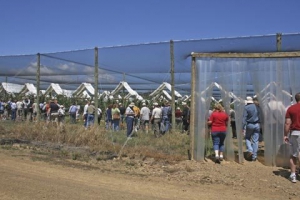Tasmanian orchardist Tim Reid has found a niche selling Japanese cherries to Japan.
Reid had been shipping Western black cherries to Japan, when a customer suggested that instead of trying to push those cherries onto the market, he should be growing Japanese varieties that are in greater demand there.
During the off-season, a small number of Japanese growers produce cherries in hothouses. Reid said one Japanese grower produced two tons of hothouse cherries and sold them for the equivalent of Aus.$5,000 per kilo (U.S.$1,788 per pound).
Reid saw an opportunity to grow them in Tasmania in the off-season and export them to Japan. He lined up strategic partners in both Japan and Australia and in 1999 and 2000 imported cuttings of the white-fleshed Japanese varieties Sato Nishiki and Beni Shuho into Australia. He then had to negotiate with both the Australian and Japanese governments to gain access to Japan for the fruit he would grow after wood went through quarantine and trees were propagated. In the process, he gained access to Japan for the whole Tasmanian cherry industry.
Reid selected a new site for the venture at Plenty in the Derwent Valley, which receives only 16 inches of rain—less than half the annual rainfall in the Huon Valley, where he also has orchard. The new 700-acre site, formerly open ground, has frontage on the Derwent River.
“It’s ideal,” Reid said, adding that he has a license to pump up to 5 million gallons out of the river daily for irrigation water, at very little cost. “It was an opportunity we couldn’t miss.”
Investors
It cost Aus.$10 million (U.S.$7.9 million) to purchase the land and establish the orchard. He’s planted a wide range of cherry varieties and some apples in addition to the two Japanese cherries. The cost was far more than a small business like his could afford, so he brought
in investors. That meant that he had to meet key performance indicators or pay penalties.
“I had to be able to demonstrate to the investors that we could get the cherries through quarantine successfully, we could grow them here, and we could gain access to Japan for the cherries,” he told IFTA members who visited the orchard.
Reid put the cherry trees on an open Tatura trellis system and installed both bird netting and a rain cover at a cost of Aus.$80,000 to $90,000 per hectare (more than U.S.$25,000 per acre).
“With cherries on the trees, the last thing I wanted to do was see them ruined by rain,” he said. “We had to get some cherries quickly to prove the key performance indicators. Fortunately, it all worked.”
Last season, he was able to ship his first 300 kilos (660 pounds) to Japan, which sold for Aus.$55 per kilo (U.S.$20 per pound) landed in Japan. Buyers repacked the cherries into 100-gram packs that retailed for the equivalent of Aus.$150 to $200 per kilo (U.S.$55 to $70 per pound). Reid has to pay for an inspector from the Ministry of Agriculture, Forestry and Fisheries of Japan to go to Tasmania to check the fruit, and said it wouldn’t be feasible to produce them at regular supermarket pricing.
This year, he should have had a good crop, but he lost 80 percent of the cherries in a severe October frost. He was able to export only three tons. With the acreage he has in the ground and another 13,000 trees in his nursery that he will plant in the orchard next winter, he will have almost 24 hectares (60 acres) with a production capacity of 300 tons, and expects to produce 70 to 80 percent first-grade fruit.
“We think that’s enough,” he said. “There’s a lot of cost getting them into the country.”


Leave A Comment